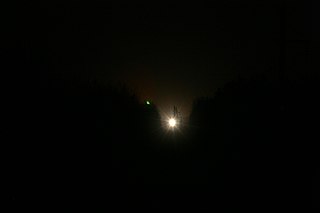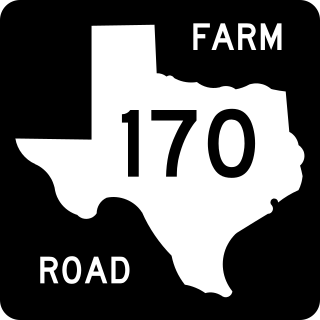
Presidio County is a county located in the U.S. state of Texas. As of the 2020 census, its population was 6,131. Its county seat is Marfa. The county was created in 1850 and later organized in 1875. Presidio County is in the Trans-Pecos region of West Texas and is named for the border settlement of Presidio del Norte. It is on the Rio Grande, which forms the Mexican border.

Alpine is a city in and the county seat of Brewster County, Texas, United States. The population was 6,035 at the 2020 census. The town has an elevation of 4,462 feet (1,360 m), and the surrounding mountain peaks are over 1 mile (1.6 km) above sea level. A university, hospital, library, and retail make Alpine the center of the sprawling 12,000 square miles (3,108,000 ha) but wide open Big Bend area including Brewster, Presidio, and Jeff Davis counties.

Marfa is a city in the high desert of the Trans-Pecos in far West Texas, United States, between the Davis Mountains and Big Bend National Park, at an elevation of 4685 feet. It is the county seat of Presidio County, and its population as of the 2020 United States Census was 1,788. The city was founded in the early 1880s as a water stop; the population peaked in the 1930s and has continued to decline each decade since. However, today Marfa is a tourist destination and a major center for minimalist art. Attractions include Building 98, the Chinati Foundation, artisan shops, historical architecture, a classic Texas town square, modern art installments, art galleries, and the Marfa lights.

Presidio is a city in Presidio County, Texas, United States. It is situated on the Rio Grande River, on the opposite side of the U.S.–Mexico border from Ojinaga, Chihuahua. The name originates from Spanish and means "fortress". The population was 4,169 at the 2000 census, and had increased to 4,426 as of the 2010 US census.

U.S. Route 67 is a major north–south U.S. highway which extends for 1,560 miles (2,511 km) in the Central United States. The southern terminus of the route is at the United States-Mexico border in Presidio, Texas, where it continues south as Mexican Federal Highway 16 upon crossing the Rio Grande. The northern terminus is at U.S. Route 52 in Sabula, Iowa. US 67 crosses the Mississippi River twice along its routing. The first crossing is at West Alton, Missouri, where US 67 uses the Clark Bridge to reach Alton, Illinois. About 240 miles (390 km) to the north, US 67 crosses the river again at the Rock Island Centennial Bridge between Rock Island, Illinois, and Davenport, Iowa. Additionally, the route crosses the Missouri River via the Lewis Bridge a few miles southwest of the Clark Bridge.

The Big Bend is part of the Trans-Pecos region in southwestern Texas, United States along the border with Mexico, north of the prominent bend in the Rio Grande for which the region is named. Here the Rio Grande passes between the Chisos Mountains in Texas and the Sierra Madre Oriental in Mexico as it changes from running east-southeast to north-northeast. The region covers three counties: Presidio County to the west, Brewster County to the east, and Jeff Davis County to the north.
The Hessdalen lights are unidentified lights which have been observed in a 12-kilometre-long (7.5 mi) stretch of the Hessdalen valley in rural central Norway periodically since at least the 1930s.

The Min Min light is a light phenomenon that has often been reported in outback Australia.

Black triangles are UFOs reported as having a triangular shape and dark color, typically observed at night, described as large, silent, hovering, moving slowly, and displaying pulsating, colored lights which they can turn off.

The Brown Mountain lights are purported ghost lights near Brown Mountain in North Carolina. The earliest published references to strange lights there are from around 1910, at about the same time electric lighting was becoming widespread in the area. In 1922, a USGS scientist, George R. Mansfield, used a map and an alidade telescope to prove that the lights that were being seen were trains, car headlights, and brush fires, which ended widespread public concern.

Fort D. A. Russell is the name of an American military installation near Marfa, Texas, that was active from 1911 to 1946. It is named for David Allen Russell, a Civil War general killed at the Battle of Opequon, September 19, 1864.

The Spooklight is an atmospheric ghost light on the border between southwestern Missouri and northeastern Oklahoma, a few miles west of the small town of Hornet, Missouri. It is caused by the misidentification of distant car headlights.
The Gurdon Light is an atmospheric ghost light located near railroad tracks in a wooded area of Gurdon, Arkansas. It is the subject of local folklore and has been featured in local media and on Unsolved Mysteries and Mysteries at the Museum. The tracks are no longer in use, and the rails at least partially removed/covered, but it remains one of the most popular Halloween attractions in the area. The light has been described as blue, green, white or orange and appearing to have a "bobbing" movement.

The Paulding Light is a light that appears in a valley outside Paulding, Michigan. Reports of the light have appeared since the 1960s, with popular folklore providing such explanations as ghosts, geologic activity, or swamp gas.

The Chinati Foundation/La Fundación Chinati is a contemporary art museum located in Marfa, Texas, and based upon the ideas of its founder, artist Donald Judd.

Farm to Market Road 170 is a 114.6-mile (184.4 km) highway maintained by the Texas Department of Transportation (TxDOT) in Presidio and Brewster counties in Texas. The route, known locally as the River Road, runs along the United States side of the Rio Grande which in Texas forms the international boundary between the U.S. and Mexico. The road runs from Candelaria through the city of Presidio as well as several smaller communities and former settlements to State Highway 118 in Study Butte near Big Bend National Park. The road also passes through the southern portion of Big Bend Ranch State Park.

U.S. Route 67 is a major U.S. highway in the state of Texas. It runs from the U.S.–Mexico border west of Presidio to Texarkana at the Arkansas state line. US 67 is part of the La Entrada al Pacifico international trade corridor from its southern terminus to US 385 in McCamey.

Shafter is a ghost town in Presidio County, Texas, United States. The Texas Attorney General's Office listed a population of 11 as of the 2000 Census. It was named in honor of General William R. Shafter, who at one point commanded the nearby Fort Davis. As of 2012, at least one silver mine, La Mina Grande, had been reopened by Aurcana Corporation.

The Chinati Mountains of Texas are a small range in the high desert of far West Texas near the city of Presidio. There is a pass through the mountains on Ranch to Market Road 2810, also known as Pinto Canyon Road, which connects to Farm to Market Road 170 at Ruidosa, Texas. Some believe the range derives its name from the Apache word ch'íná'itíh, which means gate or mountain pass.

Chinati Hot Springs, also known as Ruidosa Hot Springs and Kingston Hot Springs, are volcanic thermal springs and historical oasis located north of Ruidosa, Texas in the Big Bend region of the Chihuahuan Desert, near the town of Presidio.

















